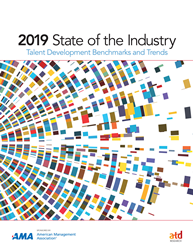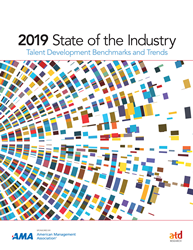
“It’s not surprising that organizations are concerned about managerial skills; the ATD report Bridging the Skills Gap finds that nearly two-thirds of TD professionals thought their organization was experiencing a ‘gap’ in managerial and supervisory skills.” — Maria Ho, ATD Research.
ALEXANDRIA, Va. (PRWEB)
December 11, 2019
Despite a slowing of global economic activity in the second half of 2018, organizations continued to make a significant investment in employee learning, according to ATD’s 2019 State of the Industry report.
The publication, sponsored by American Management Association International, showed the average organization had a direct learning expenditure of $1,299 per employee in 2018 and each worker used 34 hours (slightly higher than four eight-hour workdays) on formal learning.
According to the report, “Learning hours have held quite stable in recent years; in both 2017 and 2016, the average number of learning hours used was 34.1, which is almost identical to this year’s figure. The traditional instructor-led classroom continues to be of major importance as more than half of these hours were delivered in that setting.”
Organizations continue to focus on managerial and supervisory employee development. This has been the top content spot for the last several years in terms of the percentage of the learning portfolio dedicated to it.
“It’s not surprising that organizations are concerned about managerial skills; the ATD report Bridging the Skills Gap: Workforce Development and the Future of Work finds that nearly two-thirds of talent development professionals thought their organization was experiencing a “gap” in managerial and supervisory skills,” says Maria Ho, associate director of ATD Research.
ATD’s 2019 State of the Industry report is based on data from 318 organizations of various sizes, industries, and locations. Key findings were that:
-
62 percent of direct learning expenditure went toward internal services (talent development staff salaries, in-house development, delivery, and administration expenses for example); 27 percent went to learning suppliers; and 11 percent went to tuition reimbursement. - 14 percent of the learning budget went to managerial and supervisory training while compliance came in at 13 percent.
- 54 percent of the formal learning hours used were delivered using the traditional, live, face-to-face classroom while 22 percent were delivered as online, self-paced e-learning programs.
Learning experiences that happen during work are critical to employee development. In 2018, 55 percent of organizations emphasized on-the-job training to a high or very high extent. Another 33 percent highlighted it to a moderate extent.
The 2019 State of the Industry report is free to ATD members at td.org/SOIR2019, on the ATD Publications app, and available for purchase in the ATD Store during conferences. ATD is also hosting a free webcast featuring the State of the Industry report on January 29, 2020. Register here.
About ATD
The Association for Talent Development (ATD) is the world’s largest professional membership organization supporting those who develop the knowledge and skills of employees, improve performance, and help to achieve results for the organizations they serve. Originally established in 1943, the association was previously known as the American Society for Training & Development (ASTD).
ATD’s members come from more than 120 countries and work in public and private organizations in every industry sector. ATD supports talent development professionals who gather locally in volunteer-led U.S. chapters and international member networks, and with international strategic partners.
For more information, visit td.org.
Share article on social media or email:

